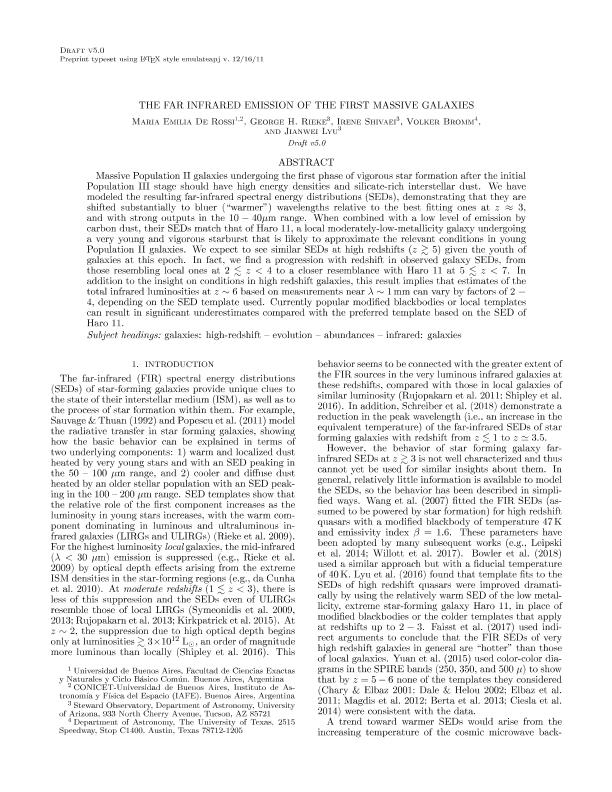Mostrar el registro sencillo del ítem
dc.contributor.author
de Rossi, Maria Emilia

dc.contributor.author
Rieke, George H.
dc.contributor.author
Shivaei, Irene
dc.contributor.author
Bromm, Volker
dc.contributor.author
Lyu, Jianwei
dc.date.available
2019-10-18T15:27:36Z
dc.date.issued
2018-10
dc.identifier.citation
de Rossi, Maria Emilia; Rieke, George H.; Shivaei, Irene; Bromm, Volker; Lyu, Jianwei ; The Far-infrared Emission of the First Massive Galaxies; IOP Publishing; Astrophysical Journal; 10-2018
dc.identifier.issn
0004-637X
dc.identifier.uri
http://hdl.handle.net/11336/86351
dc.description.abstract
Massive Population II galaxies undergoing the first phase of vigorous star formation after the initial Population III stage should have high energy densities and silicate-rich interstellar dust. We have modeled the resulting far-infrared spectral energy distributions (SEDs), demonstrating that they are shifted substantially to bluer (`warmer´) wavelengths relative to the best fitting ones at z ~ 3, and with strong outputs in the 10 - 40 micron range. When combined with a low level of emission by carbon dust, their SEDs match that of Haro 11, a local moderately-low-metallicity galaxy undergoing a very young and vigorous starburst that is likely to approximate the relevant conditions in young Population II galaxies. We expect to see similar SEDs at high redshifts (z >= 5) given the youth of galaxies at this epoch. In fact, we find a progression with redshift in observed galaxy SEDs, from those resembling local ones at 2 < z < 4 to a closer resemblance with Haro 11 at 5 < z < 7. In addition to the insight on conditions in high redshift galaxies, this result implies that estimates of the total infrared luminosities at z ~ 6 based on measurements near lambda ~ 1 mm can vary by factors of 2 - 4, depending on the SED template used. Currently popular modified blackbodies or local templates can result in significant underestimates compared with the preferred template based on the SED of Haro 11.
dc.format
application/pdf
dc.language.iso
eng
dc.publisher
IOP Publishing

dc.rights
info:eu-repo/semantics/openAccess
dc.rights.uri
https://creativecommons.org/licenses/by-nc-sa/2.5/ar/
dc.subject
GALAXIES: HIGH-REDSHIFT
dc.subject
GALAXIES: EVOLUTION
dc.subject
GALAXIES: ABUNDANCES
dc.subject
INFRARED: GALAXIES
dc.subject.classification
Astronomía

dc.subject.classification
Ciencias Físicas

dc.subject.classification
CIENCIAS NATURALES Y EXACTAS

dc.title
The Far-infrared Emission of the First Massive Galaxies
dc.type
info:eu-repo/semantics/article
dc.type
info:ar-repo/semantics/artículo
dc.type
info:eu-repo/semantics/publishedVersion
dc.date.updated
2019-10-17T19:11:02Z
dc.journal.pais
Reino Unido

dc.journal.ciudad
Londres
dc.description.fil
Fil: de Rossi, Maria Emilia. Consejo Nacional de Investigaciónes Científicas y Técnicas. Oficina de Coordinación Administrativa Ciudad Universitaria. Instituto de Astronomía y Física del Espacio. - Universidad de Buenos Aires. Facultad de Ciencias Exactas y Naturales. Instituto de Astronomía y Física del Espacio; Argentina
dc.description.fil
Fil: Rieke, George H.. University of Arizona; Estados Unidos
dc.description.fil
Fil: Shivaei, Irene. University of Arizona; Estados Unidos
dc.description.fil
Fil: Bromm, Volker. University of Texas at Austin; Estados Unidos
dc.description.fil
Fil: Lyu, Jianwei. University of Arizona; Estados Unidos
dc.journal.title
Astrophysical Journal

dc.relation.alternativeid
info:eu-repo/semantics/altIdentifier/doi/http://dx.doi.org/10.3847/1538-4357/aaebf8
Archivos asociados
